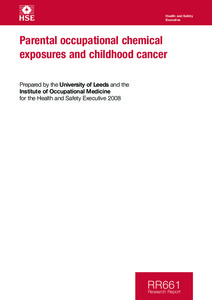Parental occupational chemical exposures and childhood cancer
"The risk of childhood cancer has been inconsistently linked with parental exposure to occupational agents, partly because of poor exposure assessment. Interview data from the UK Childhood Cancer Study, an epidemiological case control study, was used to extend previous analyses of parental occu...
| Main Authors: | , , |
|---|---|
| Institution: | ETUI-European Trade Union Institute |
| Format: | TEXT |
| Language: | English |
| Published: |
Sudbury
2008
HSE Books |
| Subjects: | |
| Online Access: | https://www.labourline.org/KENTIKA-19188806124919060889-Parental-occupational-chemical.htm |
| Summary: | "The risk of childhood cancer has been inconsistently linked with parental exposure to occupational agents, partly because of poor exposure assessment. Interview data from the UK Childhood Cancer Study, an epidemiological case control study, was used to extend previous analyses of parental occupations. Specific work related exposures were examined as possible risk factors for childhood leukaemia and lymphoma for three exposure time windows (preconception, pregnancy, postnatal). A new exposure assessment method was designed to derive a final ‘reviewed’ exposure status which was externally validated against an independent expert assessment.
As observed elsewhere mothers had a lower prevalence of exposure to chemical agents at work (18%) compared to fathers (44%). In order to refine exposure assessment all available data was examined. Parents self reported being exposed in over 24,000 jobs; the reviewed exposure assessment reduced the numbers of reported exposures, reclassifying 33% of mothers and 50% of fathers as exposed. Many statistically significant risks for self-reported exposure disappeared when applying the reclassified exposure. For the refined exposure assessment, maternal exposure to solvents during pregnancy remained a statistically significant risk for acute lymphoblastic leukaemia with a dose-response relationship. Paternal exposure to fertilisers during pregnancy and postnatally were associated with acute lymphoblastic leukaemia and Hodgkin Lymphoma but without dose-response relationships.
The designed exposure assessment method represents a novel approach for evaluating parental occupational exposure for use in future studies. The findings for mothers for the generic group of solvents warrants further independent research. Overall, findings must invoke caution in the interpretation of risk estimates reliant on ‘self-reported’ occupational exposure in epidemiological investigations." |
|---|---|
| Physical Description: | 95 p. Paper Digital |

